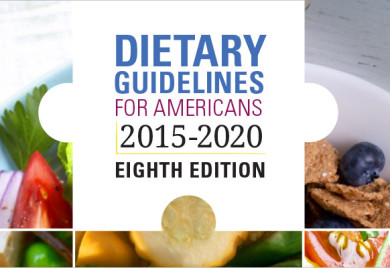8 Key Steps to Putting the 2015 Dietary Guidelines in Action

This article was written by Amanda Miller, a Nebraska Extension Volunteer and Registered Dietitian
The 2015 Dietary Guidelines are out and with them comes new recommendations. As you might have guessed, Americans continue to fall short of the recommended intake for fruits, vegetables, whole grains, and oils while over-consuming added sugar, saturated and trans fats, and sodium. The goal of this article is to give you a brief overview of the updated guidelines and most importantly, provide simple tips to help you get a little closer to meeting the dietary guidelines.
The key recommendations include:
- Eat a variety of vegetables
- Focus on eating whole fruit
- Make at least half your grains whole grains
- Choose fat-free or low-fat dairy products
- Choose a variety of protein-rich foods such as fish, eggs, lean meat, poultry, nuts, seeds, beans, and peas
- Choose oils over saturated fats such as butter, margarine, coconut oil, etc.
- Limit added sugar to < 10% of your total calories
- Limited saturated fat to < 10% of your total calories
- Limit sodium to < 2300 mg/day
Those familiar with previous dietary guidelines might have noticed that the 2015 Dietary Guidelines are similar to those in the past; however, there are two recommendations that are distinctly different. First of all, the current guidelines have loosened the previous restriction on cholesterol-containing foods such as egg yolks and shellfish. The current guidelines have removed the recommended limit of < 300 mg cholesterol/day that was part of the 2010 Dietary Guidelines. This was due to lack of evidence to support a definitive limit for dietary cholesterol and the uncertainty of whether dietary cholesterol actually impacts blood cholesterol levels. Often times, foods that are high in cholesterol are also high in saturated fat (which has been linked to increased blood cholesterol). However, a few foods, specifically egg yolks and shellfish, are high in cholesterol but not saturated fats. Therefore, the current guidelines suggest that eggs and shellfish can be consumed along with a variety of other foods as part of an overall healthy diet pattern.
Secondly, the 2015 Dietary Guidelines established a certain percentage of calories that Americans should keep their added sugar intake under: < 10% of total calories. This would be < 50 grams of added sugar/day for a 2,000-calorie diet (or approximately 1 bottle of soda/day). When looking at America’s current dietary pattern, the majority of Americans are consuming > 13% of their calories from added sugar. The age group with the highest percentage of calories from added sugar was 9-18 year olds with an average of nearly 17% of caloric intake. So where is all of this sugar coming from? According to the report, nearly half of added sugar in the American diet comes from sugar-sweetened beverages and nearly a third comes from snacks/sweets. Sugar intake is often overlooked, but aiming to keep sugar intake at the recommended intake of < 10% total calories may help prevent weight gain and decrease the risk of cardiovascular disease.
Here are 8 simple steps you can take to put the new guidelines into action:
- Ditch the sugary beverages – drink water instead. To mix things up, try infusing water with your favorite fruits and herbs.
- Check the label – avoid buying products that list sugar (or any form of sugar) as the first or second ingredient.
- Choose whole grains more often by swapping your white bread for whole wheat bread, choosing whole grain cereals such as oatmeal or cheerios, and substituting brown rice for white rice. Look for the words “whole grain” or “whole wheat” as the first ingredient when looking for whole grain products at the grocery store.
- Fill ½ your plate with vegetables at lunch and dinner.
- Include a serving of fruit with your breakfast each morning. Try topping your toast with peanut butter and banana slices; adding frozen berries to cereal, oatmeal, or yogurt; or making a smoothie with frozen fruit, milk, and yogurt.
- Remember to eat a wide variety of protein-rich foods. Fish, poultry, lean meats, eggs, shellfish, beans, nuts, tofu, and seeds are all great sources of protein.
- Substitute oils (that are liquid at room temp) for solid fats such as butter when cooking.
- Aim for three servings of low-fat or fat-free dairy each day. Milk, yogurt, and cheese all count towards your dairy intake.
Try to choose nutrient-dense foods such as fruits, vegetables, whole grains, lean protein, and low-fat dairy most often. Limit foods and beverages that provide empty calories such as soda, candy, French fries, and chips. Although it might seem like a big leap to meet each and every recommendation from the 2015 Dietary Guidelines, every small step you take towards achieving a healthier diet can play a big role in improving your health. Take it one day at a time, one step at a time!




